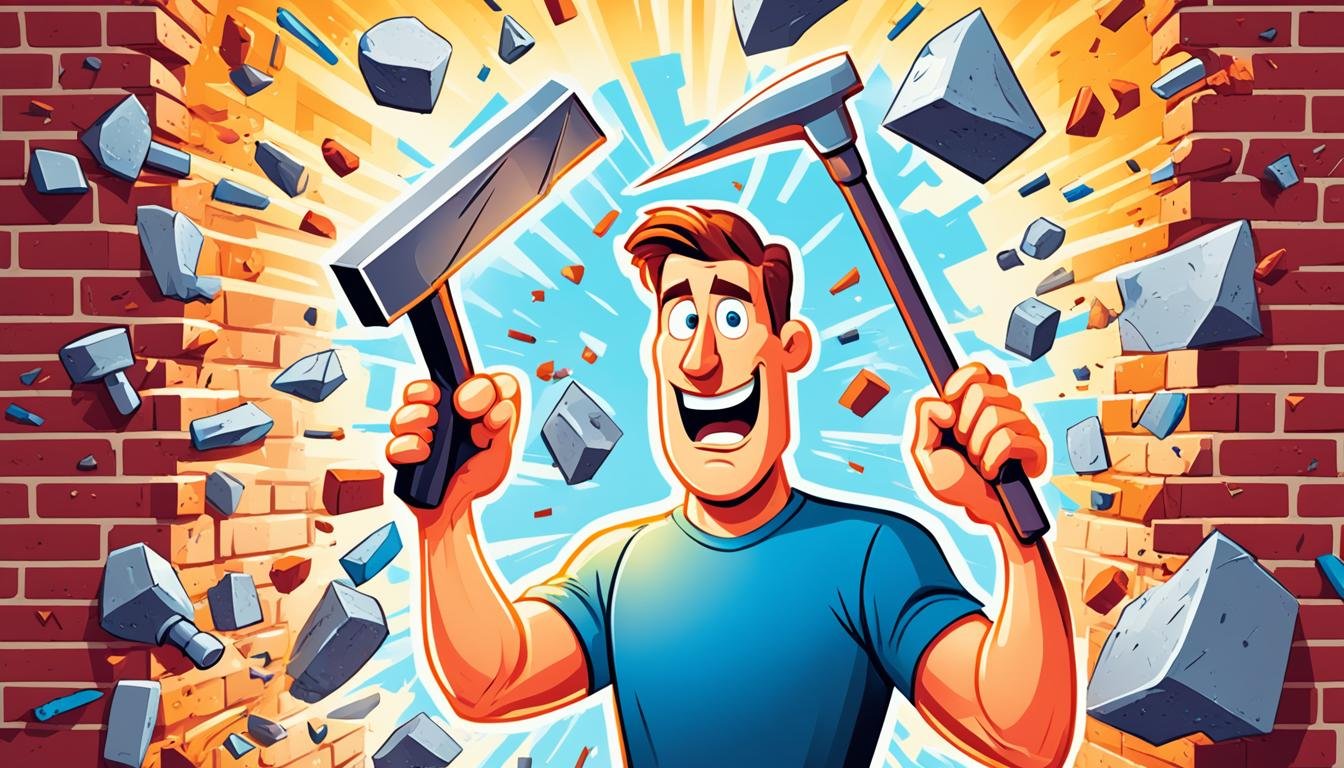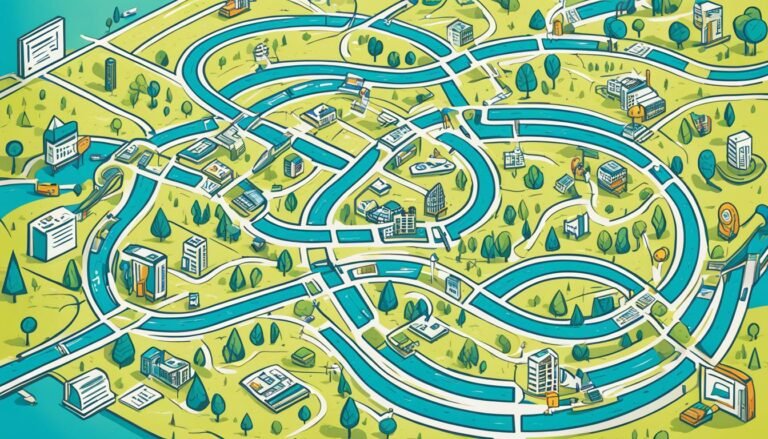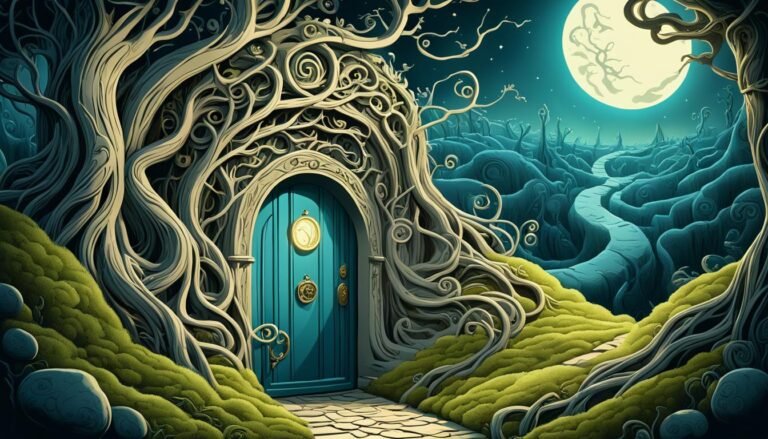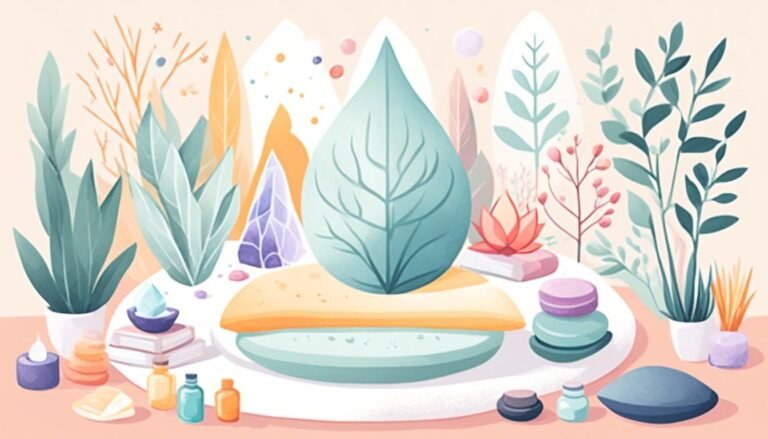Creative Blocks: Psychological Strategies for Overcoming Them
Have you felt stuck in a creative rut before? It’s when good ideas stay hidden away and you feel uninspired. We all face this from time to time. But, don’t worry. There are ways to bust through these blocks. You can get your creative juices flowing again.
In this piece, we’ll look into what causes creative blocks. And, we’ll share strategies to help you move past them. This way, you can use your creativity to the fullest and find the inspiration you need.
Key Takeaways:
- Recognize the various factors that contribute to creative blocks
- Explore therapy as a valuable resource to overcome creative blockage
- Give yourself permission to take breaks and step away from your creative projects
- Establish a creative routine to provide structure and consistency
- Embrace constraints to narrow down options and ease decision-making
Understanding Creative Blocks
Creative blocks are roadblocks that stop our creative flow. They can leave us without ideas or energy, disrupting our projects. It’s essential to know why these blocks happen to beat them and find our creative drive again.
Many things can cause a creative block. Things like feeling sad or worried can make it hard to think creatively. Not sleeping enough or being too stressed also stunts our creativity. Wanting everything to be perfect, and being scared to fail, can also stop us from trying new ideas.
“Creative inspiration is the unconscious mind bursting with ideas, while creative blockage is the conscious mind getting in the way.”
– Elizabeth Gilbert
Recognizing and Addressing Creative Blocks
First, you need to spot a creative block. Paying attention to what’s stopping you from being creative is crucial. It could be stress, how well you sleep, or how you feel. Figuring this out helps you know what to work on.
To help find and deal with creative block, try these steps:
- Think about your feelings and write them down.
- Talk to people who know how tough it can be to stay creative.
- Try new ways to get creative again, like different exercises.
Exercise: Brainstorming Causes of Creative Blocks
Think about what might be causing your creative block. Write down how you feel and what’s happening around you. Doing this in a table can make it clearer what’s affecting your creativity.
| Potential Causes of Creative Blocks |
|---|
| Mental health challenges (e.g., anxiety, depression) |
| Lack of sleep and fatigue |
| High levels of stress |
| Perfectionism and fear of failure |
| Lack of inspiration from external sources |
| Overwhelming workload or expectations |
Knowing why creative blocks happen is the first step to beat them. By understanding what’s really causing your block, you can come up with ways to feel more inspired and motivated.
Therapy for Creative Blocks
Feeling stuck in your creativity? Therapy is a great way to move forward. A mental health professional can help you find out what’s really causing your block. They offer support and advice to get your creative juices flowing again.
Cognitive behavioral therapy, or CBT, is one way to deal with creative blocks. It helps you spot and change negative thoughts and actions. By turning bad thoughts into good ones, you can let your creativity shine.
Mindfulness is also a big help. This method focuses on being in the moment to calm your mind. Techniques like meditation can clear your thoughts, leaving room for new ideas to flourish.
Then there’s art therapy, where you use art to work through your emotions. It’s all about self-discovery and expression. Through art, you might find new ways to unleash your creativity.
“Therapy is a safe space to face your creative hurdles. It arms you with the tools you need to find your way back to inspiration.”
Therapy offers a quiet space to dig deep and recognize your personal barriers. It’s a comforting place to deal with the emotional struggles that block creativity.
Bouncing ideas off a therapist can help you handle stress, anxiety, and doubt. Therapy also guides you in discovering fresh paths to creativity. It’s about finding solutions and fresh starts.
Key Takeaways:
- Therapy is a valuable resource for overcoming creative blocks.
- Working with a mental health professional can help explore underlying concerns and develop coping skills.
- Cognitive behavioral therapy, mindfulness-based approaches, and art therapy are effective therapeutic approaches.
- Therapy provides a safe space to understand and address psychological factors contributing to creative blocks.
- Through therapy, individuals can develop coping skills, manage stress, and find renewed inspiration.
Taking Breaks and Stepping Away
Taking breaks from a task really helps. Walking or doing a hobby can refresh your mind. This time out lets your inner self solve the problem. It often leads to new and inspired ideas.
Recognize when your mind is tired and it’s okay to take a break. This distance helps your mind relax. The break is a chance for your mind to connect information in a new way. This is when great ideas often come.
Walking or exercising refreshes your mind too. It makes you feel happy and less stressed. Then, you’re more likely to think of something new. Studies show that this helps you think better and be more creative.
Changing your surroundings can also help. Maybe try a new hobby or read a book. This can spark your creativity and help you see your project in a new light.
“Creativity is a fragile thing. It requires space and time to breathe, to wander, and to be free. Taking breaks and stepping away from the project allows ideas to percolate and flow naturally.”
Breaks should be part of your plan, not a way to procrastinate. They help you refresh and recharge. This gives your mind the chance to find new solutions and ideas.
| Benefits of Taking Breaks and Stepping Away |
|---|
| Refreshes the mind |
| Allows new ideas to emerge |
| Reduces mental fatigue |
| Stimulates creativity |
| Provides new perspectives |
Establishing a Creative Routine
Consistency is the secret to beating creative blocks and boosting productivity. A steady creative routine sets the scene for success. It helps people push through when creativity stops flowing.
It’s crucial to have a set time daily for creative work. Even without motivation, showing up and starting can change everything. This routine turns challenging tasks into easy habits and helps jump over creative hurdles.
Focusing on creating, not on being perfect, is vital for a creative routine. Choosing progress over perfection leads to better work over time. Breakthroughs come from steady effort, especially in hard creative times.
Having a set routine adds structure and predictability to life. It takes away the stress of deciding when to be creative. This free mind can then fully focus on the creative task at hand.
Consistency is not about being perfect; it’s about being committed to progress.
A creative routine also builds discipline. It makes us more responsible and less likely to get distracted. It shows us that creativity should be a top priority every day.
Practicing self-care alongside creativity can really boost your success. Taking breaks and immersing yourself in rejuvenating activities can do wonders. This refreshes the mind, making creativity flow even better.
Key Benefits of Establishing a Creative Routine
- Consistency and structure
- Improved accountability and discipline
- Reduced decision fatigue
- Growth mindset
- Enhanced overall well-being
- Consistency and structure
- Improved accountability and discipline
- Reduced decision fatigue
- Growth mindset
- Enhanced overall well-being
A creative routine is a game changer for getting over creative hurdles and enhancing output. It involves setting regular creative work hours, focusing on progress, and caring for oneself. This approach unlocks hidden creativity and deepens the joy in creative pursuits.
Embracing Constraints
When you hit a wall in your creativity, working within limits can help break you free. Instead of being lost in too many choices, constraints steer you right. They let you know where to go, making your path clearer.
These limits can actually boost your creative thinking. They push you to come up with new, clever solutions. Working with boundaries opens up fresh ways of looking at things. It brings out the best in your ideas.
“The artist thrives on limitation.” – Wassily Kandinsky
Getting used to limits helps you see the big picture clearly. You know exactly what you can and can’t do. This focus trims away the distractions, letting you really dig into your project.
Benefits of Embracing Constraints
1. Focused Mind: Limits cut through the noise, helping you zone in on what really counts. This sharpens your focus. You get to put all your effort and thoughts into making your project shine.
2. Nimble Problem-Solving: Constraints make you think on your feet. They push you to find new, original answers within the rules. This can turn into surprising, cool results that not everyone might come up with.
3. Easier Choices: Too many choices can be a real headache. Limits make decisions simpler. You look at your choices based on how well they fit with what you have to work with.
Embracing limits gives you room to breathe. It helps you work smarter on your creative journey. With a clear map in your mind, you’re more likely to reach exciting new destinations.
Brainstorming and Mind Mapping
When you’re stuck on new ideas, brainstorming and mind mapping can break the block. They let you think freely and explore unseen paths. This opens the door to new creative solutions.
Brainstorming is about dumping every thought onto paper, no holding back. Don’t worry if an idea seems off the wall. This method helps your brain jump from idea to idea, boosting creativity. Letting ideas flow without judgement is the trick.
Mind mapping visually lays out your thoughts. It’s like drawing a roadmap of your ideas, showing how they’re connected. This method helps you see your thoughts clearly and find new links. It spices up your creativity.
Both brainstorming and mind mapping give you a roadmap to creativity. They let you see things from different angles, encouraging fresh ideas. Following these steps, you won’t hit a wall in creativity. You’ll find new and exciting thoughts.

Unlocking Creativity Through Brainstorming and Mind Mapping
Introducing brainstorming and mind mapping in your creative routine comes with many pluses:
- Idea Generation: They spark dozens of ideas, broadening your options and boosting creative juices.
- Visualization: Using mind maps helps you see your ideas clearer, finding hidden ties and patterns.
- Collaboration: They’re great for working with others, encouraging sharing ideas and gaining different insights.
- Organized Thinking: Mind maps tidy up your thoughts, making your creative process smoother and clearer.
- Overcoming Constraints: They push you to think uniquely, breaking through mental blocks and finding innovative answers.
By using brainstorming and mind mapping, you’ll beat creative lulls, welcoming new thoughts and big breakthroughs. Albert Einstein wisely pointed out that “Imagination is more important than knowledge.” This shows how using these tools can really let your creativity loose.
Seeking Inspiration from Others
Facing creative blocks is tough. But, getting inspired by others can help a lot. Talk to creative people, read books, or listen to podcasts. These actions can bring fresh ideas to your projects.
Reading opens doors to new worlds and ideas. It’s a great way to learn and get inspired. By reading different kinds of books, you’ll broaden your view. You might find inspiration from fantasy novels, science books, or the life stories of creative people.
Listening also sparks inspiration. Podcasts, interviews, and TED Talks are great for this. They let you hear from experts and creatives. You’ll learn from their experiences and get new ideas.
“Creativity is contagious. Pass it on.” – Albert Einstein
Talking to creative folks is inspiring too. Sharing your thoughts and challenges can lead to new ideas. Try connecting with others through social media or local groups. This can help you build on each other’s creativity.
Recommended Books for Creative Inspiration:
| Title | Author |
|---|---|
| The Artist’s Way | Julia Cameron |
| Big Magic | Elizabeth Gilbert |
| Show Your Work! | Austin Kleon |
| The War of Art | Steven Pressfield |
| Steal Like an Artist | Austin Kleon |
Inspiration can come from anywhere, even unexpected places. Stay open to new experiences and ideas. Seeking inspiration from others helps you grow. It lets you beat your creative blocks and find your creative voice.
Creating an Optimal Work Environment
Fostering creativity and beating blocks start with the right work setup. Reduce noise, turn off gadgets, and choose a calm place. This helps people concentrate better and get more done. It also lets them dive deep into their creative processes without being interrupted.
To keep focused, we must cut out what distracts us. For example, we should close extra computer tabs and silence our phones. A clean, tidy workspace also helps a lot.
Having a private area for work makes it easier to stay on track. It could be a room of your own, a quiet corner, or a coworking spot. Be sure to fill this space with things that inspire you.
Setting ground rules and talking to others about your work time is key. Tell them when you need peace and quiet for creativity. This can prevent unwanted interruptions.
Everyone’s perfect work environment is different. Try various setups to see what improves your focus. The goal is to have a place that lets you concentrate and be creative.
Creating an Optimal Work Environment: Key Strategies
- Minimize distractions by closing unnecessary applications and silencing technology.
- Designate a clean and organized workspace to enhance focus.
- Find a quiet and dedicated space for creative work.
- Establish boundaries and communicate your need for uninterrupted creative time.
- Experiment with different setups to find what works best for you.
Using these techniques helps build the perfect space for working creatively. With just a few tweaks, your working area can support your creativity much better. Small changes make a big difference in staying sharp and unlocking your creative side.
Letting Go of Perfectionism
Overcoming creative blocks is about more than finding new tricks. It means changing your way of thinking. This includes letting go of perfectionism and learning to accept imperfections. Trying to be perfect stops creativity and slows progress. When we understand that perfection is impossible, we can try new things without fear.
Finding freedom in imperfection is powerful. It means not everything we make will be perfect, and that’s ok. Imperfections can make our work unique and real. It’s better to make progress than to seek perfection. Each small step we take gets us closer to our creative dreams.
“Perfection is not attainable, but if we chase perfection we can catch excellence.” – Vince Lombardi
Letting go of perfectionism changes our mindset and helps us overcome creative barriers. Instead of struggling for perfection, we enjoy the process of creating and growing. This change opens us to more experimentation and leads to remarkable discoveries.
Accepting less than perfect does not mean being ok with mediocrity. It’s about balancing the desire for top quality with understanding that slip-ups are part of creation. Ditching perfectionism unlocks our creativity and allows freedom to innovate without holding back.
| Benefits of Letting Go of Perfectionism: | Strategies to Embrace Imperfection: |
|---|---|
| 1. Increased creative freedom | 1. Start small and build confidence |
| 2. Reduced fear of failure | 2. Embrace mistakes as learning opportunities |
| 3. Unlocking new perspectives | 3. Practice self-compassion |
| 4. Enhanced innovation and experimentation | 4. Focus on progress rather than perfection |
| 5. Greater enjoyment and fulfillment in the creative process | 5. Surround yourself with a supportive community |
Letting go of perfectionism is a personal journey. It requires work and patience to embrace imperfection. But by focusing on growth and learning, we can leave behind the perfectionist mindset. This helps us unleash our creativity fully.
Incorporating Exercise and Physical Activity
Trying to boost your creativity? Exercise can really help. It makes your body release endorphins. These are chemicals that make you feel good.
When you take a break from being creative, moving can reset your brain. You can run, do yoga, or just take a walk. These activities clear your mind and help you get new ideas.
Do you want to be smarter and more creative? Exercise helps with that too. It’s not just good for your body. It also improves how well your brain works and how creative you are.
If your creative work feels stuck, try exercising every day. Find something you like to do. Making it a habit can make you healthier and more creative.
| Benefits of Incorporating Exercise | Ways to Add Physical Activity |
|---|---|
|
|
Finding Inspiration through Exercise
Exercise helps your creativity. It can inspire you. Moving and seeing new things can bring fresh thoughts and ideas.
When you’re active, your mind can freely think. You could solve problems in new ways. Being free to move helps your brain connect different thoughts.
Also, exercising reduces stress. It makes your mind clearer. This leads to more room for creative ideas to come in.
Next time you’re stuck, take a break to exercise. It helps your body and mind. And it might just give you the new idea you’re looking for.
Regular exercise is key to beating creative blocks. It brings a mix of good things like endorphins and clear thoughts. Exercise helps bring out your creative side. So, move more and see your creativity grow.
Conclusion
Breaking through creative blocks involves understanding what causes them and using certain mental tricks. You should take breaks and have a regular creative schedule. Also, don’t be afraid of limited resources or thinking hard about ideas. Finding inspiration, setting up a good workspace, not worrying about making things perfect, and staying active can all help. These steps will help you become more creative and overcome any block you face.
It’s crucial to know that creative blocks happen to everyone. Progress might not be steady, but it will come if you keep trying new things. By persevering and testing different methods, you can beat these blocks. This way, you’ll foster a more creative mind.
To wrap it up, tackling creative blocks involves knowing what causes them and using mental tactics. Stick to a creative routine, think outside the box, look for inspiration everywhere, and create a space that boosts your productivity. Remember, it’s okay not to be perfect and to stay active. With these strategies, anyone can move past creative blocks and let their creativity flourish.








